Get to Know the ISIAQ Student Travel Award Winners
ISIAQ acknowledges the importance of having students at the conference and is deeply committed to involving students in its activities. We therefore offer awards to help students attend ISIAQ conferences. In 2024, ISIAQ is supporting five students to attend the Indoor Air 2024 conference: Saptarshi Ghosh, Supreet Kaur, Mahender Singh Rawat, Zidong Song, and Ruiji Sun.
Saptarshi Ghosh
Saptarshi Ghosh is a Ph.D. student in the Environmental Science and Engineering Department in IIT Bombay, Mumbai, India.
How did you get interested in indoor air?My master's dissertation is on nanomaterials application for the remediation of emerging pollutants, that project and enormous guidance from my advisor (Prof. Mandal) had cemented my interest towards aerosol research.
What are you interested in working on next?My research interest includes synthesis of novel nanomaterials in an aerosol reactor and applications of nanomaterials as a heterogeneous catalyst in an environmental remediation.
What are you looking forward to most about Indoor Air 2024?Well, presenting my work on this platform is a good opportunity as I can present my work before indoor air quality experts worldwide from various fields and correspondingly get their valuble suggestions. Additionally, it will help in making new contacts which may provide future connections and collaborations.
Check out Saptarshi's poster, "ESP integrated photocatalytic reactor for the removal of bioaerosols from the indoor air: A hybrid approach" at the Indoor Air conference in July.
Supreet Kaur
Supreet Kaur holds the position of Senior Research Scholar in the Environmental Sciences and Biomedical Metrology Division at CSIR-National Physical Laboratory (NPL), Delhi; Academy of Scientific & Innovative Research, Ghaziabad, UP, India. Additionally, she serves as an Assistant Professor (Guest) teaching Environmental Sciences to undergraduates at MSCW, University of Delhi, India. Her work focuses on environmental research and education, with a particular interest in areas such as air quality and biodiversity.
How did you get interested in indoor air?My interest in indoor air quality and indoor environments stems from the pressing issue of urbanization and its adverse effects on human health and well-being. With over half of the global population residing in cities, access to fresh air and natural surroundings has become increasingly limited, raising concerns about the detrimental impact on public health. Compounding this issue is the significant amount of time individuals spend indoors, where air quality often deteriorates due to insufficient pollution control measures.
Recognizing the pivotal role of plants in outdoor environmental management, I am compelled to explore their potential in creating healthier indoor environments. Through my doctoral research, I aim to address fundamental inquiries surrounding the impact of plants on indoor air quality. Pilot studies conducted thus far have examined various facets, including the influence of plant-induced humidity on particulate matter concentration, indoor-outdoor particulate matter exchange dynamics, and the quantification of biogenic volatile organic compound emissions from indoor plants. Additionally, investigations have delved into the effects of indoor plants on airborne microbial proliferation and plant health in controlled indoor settings.
By offering a comprehensive perspective on indoor plantation dynamics, my research endeavors to provide valuable insights for the scientific community and innovators alike. Ultimately, the elucidation of these phenomena holds considerable promise in fostering sustainable approaches to indoor environmental management and enhancing human well-being.
What are you looking forward to about Indoor Air 2024?The Indoor Air 2024 conference promises to be an exciting event that not only showcases cutting-edge scientific research but also offers a multidisciplinary perspective across various fields. As an attendee, I look forward to expanding my horizons by engaging with subject experts from the scientific community and participating in their workshops throughout the conference.
This unique opportunity will allow me to connect with fellow researchers, receive guidance for my career, and establish valuable scientific connections. I am also hopeful for potential academic collaborations that can contribute significantly to my professional growth.
Where is your research and work going next?Driven by a commitment to research and education, I am actively seeking opportunities to secure a position in academia or within a research institution. My focus lies in delving into the development of a sustainable model aimed at fostering a healthy indoor environment through the exploration of urban floral diversity and its impact on indoor air quality.
See Supreet present on July 8, July during the poster session themed ‘Indoor Chemistry, Sources, and Transformation.’ The title of Supreet’s presentation is ‘Quantitative Analysis of Biogenic Volatile Organic Compound Emission from Syngonium Plant: Potential Implications for Human Health.’
Mahender Singh Rawat
Mahender Singh Rawat is a 4
th year Ph.D. candidate in the Department of Civil and Environmental Engineering at Clarkson University.
How did you get involved in the field of indoor air?I began working on a project in India at Indian Institute of Technology Delhi (2019) where my primary role was to conduct personal monitoring of pregnant women and asthmatic children for exposure to particulate matter. Later the passing of my grandfather due to COVID-19 (2020) further motivated me to understand and investigate the indoor transmission of viral diseases. This led me to join Clarkson University (2021) under the supervision of Dr. Andrea Ferro, where we have worked on several projects focused on indoor dynamics, transmission, and exposure to aerosols, including viruses and PFAS.
What are you interested in working on next?I am set to graduate in the spring of 2025 and I am open to any opportunities in the field of indoor exposure. I am interested in roles as a postdoctoral research associate in academia or positions in industry where I can continue to explore and contribute to the understanding of indoor air quality, exposure, and health.
What are you looking forward to most about the Indoor Air conference?I am looking forward to meeting many brilliant minds and leading scientists in our field at Indoor Air 2024. I am excited to share my work, receive valuable feedback to enhance my research, make good friends, learn from other research work, and stay updated on the latest advancements in our field.
Mahender will present three posters at Indoor Air: Indoor Dust Analysis of PFAS: Unravelling Size Distribution Patterns for Source and Exposure Insights; Quantifying the Impact of Hydration Levels on the Formation of Respiratory Aerosols; and a Job Candidate Poster.
Zidong Song
Zidong Song is a Ph.D. candidate in the Department of Building Science, Tsinghua University.
How did you get involved in the field of indoor air?I became interested in indoor air quality during my undergraduate studies in building science.
A course on environmental health introduced me to the profound impact of indoor pollutants on human health. This interest deepened when I participated in a research project that measured VOC levels in various indoor environments. These academic and personal experiences, combined with the mentorship of my advisor, solidified my commitment to improving indoor environments for better health and well-being.
What are you looking forward to about attending Indoor Air 2024?I'm looking forward to gaining valuable knowledge, skills, and connections that will advance my work in indoor air quality and environmental health.
What is your research focused on in the future?I will work on novel measurements of human exposure and health outcomes.
See Zidong’s presentation “Permeation Parameters for Dermal Exposure to Endocrine-Disrupting Compounds in Consumer Products” on July 9, in the session Health Outcomes and Exposure Assessment 2.
Ruiji Sun
Ruiji Sun is a Ph.D. candidate at UC Berkeley, and he works at the Center for Built Environment (CBE). See more on his personal webpage:
https://cbe.berkeley.edu/about-us/people/ruiji-sun/ How did you get interested in indoor air?In high school, I found a deep interest in architecture and was good in physics, which inspired me to pursue a double major in HVAC engineering and architecture during college. Throughout my graduate study at Carnegie Mellon University, my focus gradually shifted towards research, especially after recognizing that we spend 93% of our time indoors. I find great satisfaction in creating new knowledge and believe I can make a meaningful contribution to society through research in the built environment.
Where is your research and work going next?I will be graduating in the summer of 2025. I am interested in pursuing faculty positions in Building Science, Architectural Engineering, and Mechanical Engineering. I am also open to research positions at industry companies or national labs.
What are you looking forward to most at Indoor Air 2024?I look forward to meeting old and new friends and learning about discoveries and innovative technology in the indoor environment.
Attend Ruiji’s presentation in the symposium “Leveraging Causal Inference for Thermal Comfort, IAQ, and Building Energy” on July 8, where he will present the first part of his thesis, “Why do we need causal thinking?”.




